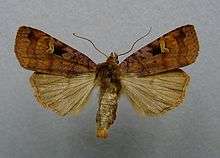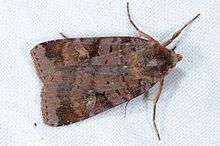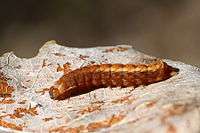Diarsia brunnea
| Diarsia brunnea | |
|---|---|
 | |
 | |
| Scientific classification | |
| Kingdom: | Animalia |
| Phylum: | Arthropoda |
| Class: | Insecta |
| Order: | Lepidoptera |
| Family: | Noctuidae |
| Genus: | Diarsia |
| Species: | D. brunnea |
| Binomial name | |
| Diarsia brunnea (Denis & Schiffermüller, 1775) | |
| Synonyms | |
| |
Diarsia brunnea, the purple clay, is a moth of the Noctuidae family. It is found in most of Europe, east to Transcaucasia, the Caucasus, central Asia, Siberia, the Kuriles, Amur, Ussuri, Sakhalin, Korea, Japan, Tibet and China.
Description
The wingspan is 35–38 mm. Forewing pinkish or purplish plumcolour; the costal half with a fulvous and yellow tinge; cell deep olive brown; claviform marked by a dark spot at its end; orbicular oblong, of the ground colour; reniform outlined or filled with ochreous; hindwing luteous fuscous; cilia pink[1]
Adults are on wing from July to August.

Larva dark brown; dorsal and subdorsal lines pale, lateral lines whitish; a row of pale yellow dark-edged oblique stripes, and a yellow stripe across segment 11. The larvae feed on a wide range of herbaceous plants and shrubs, including Rumex species (including Rumex acetosella), Dryopteris filix-mas, Luzula sylvatica, Deschampsia flexuosa, Brachypodium sylvaticum, Vaccinium myrtillus, Vaccinium uliginosum, Prunus spinosa, Primula, Rubus, Urtica, Salix and Betula.[2]
Subspecies
- Diarsia brunnea brunnea (Europe, Transcaucasia, Caucasus, central Asia, Siberia)
- Diarsia brunnea urupina (Kuriles, Amur, Ussuri, Sakhalin, Korea, Japan, Tibet, China)
References
- ↑ Seitz, A. Ed., 1914 Die Großschmetterlinge der Erde, Verlag Alfred Kernen, Stuttgart Band 3: Abt. 1, Die Großschmetterlinge des palaearktischen Faunengebietes, Die palaearktischen eulenartigen Nachtfalter, 1914
- ↑ "Robinson, G. S., P. R. Ackery, I. J. Kitching, G. W. Beccaloni & L. M. Hernández, 2010. HOSTS - A Database of the World's Lepidopteran Hostplants. Natural History Museum, London.".
External links
- Lepiforum
- Funet Taxonomy
- Fauna Europaea
- UKmoths
| Wikimedia Commons has media related to Diarsia brunnea. |